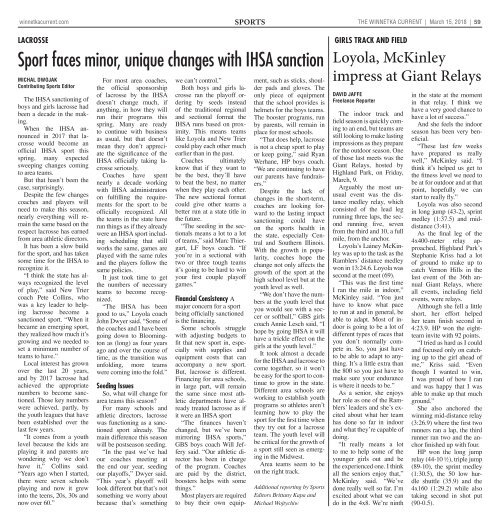WC_031518
The Winnetka Current 031518
The Winnetka Current 031518
Create successful ePaper yourself
Turn your PDF publications into a flip-book with our unique Google optimized e-Paper software.
winnetkacurrent.com sports<br />
the winnetka current | March 15, 2018 | 59<br />
Lacrosse<br />
Sport faces minor, unique changes with IHSA sanction<br />
Michal Dwojak<br />
Contributing Sports Editor<br />
The IHSA sanctioning of<br />
boys and girls lacrosse had<br />
been a decade in the making.<br />
When the IHSA announced<br />
in 2017 that lacrosse<br />
would become an<br />
official IHSA sport this<br />
spring, many expected<br />
sweeping changes coming<br />
to area teams.<br />
But that hasn’t been the<br />
case, surprisingly.<br />
Despite the few changes<br />
coaches and players will<br />
need to make this season,<br />
nearly everything will remain<br />
the same based on the<br />
respect lacrosse has earned<br />
from area athletic directors.<br />
It has been a slow build<br />
for the sport, and has taken<br />
some time for the IHSA to<br />
recognize it.<br />
“I think the state has always<br />
recognized the level<br />
of play,” said New Trier<br />
coach Pete Collins, who<br />
was a key leader to helping<br />
lacrosse become a<br />
sanctioned sport. “When it<br />
became an emerging sport,<br />
they realized how much it’s<br />
growing and we needed to<br />
set a minimum number of<br />
teams to have.”<br />
Local interest has grown<br />
over the last 20 years,<br />
and by 2017 lacrosse had<br />
achieved the appropriate<br />
numbers to become sanctioned.<br />
Those key numbers<br />
were achieved, partly, by<br />
the youth leagues that have<br />
been established over the<br />
last few years.<br />
“It comes from a youth<br />
level because the kids are<br />
playing it and parents are<br />
wondering why we don’t<br />
have it,” Collins said.<br />
“Years ago when I started,<br />
there were seven schools<br />
playing and now it grew<br />
into the teens, 20s, 30s and<br />
now over 60.”<br />
For most area coaches,<br />
the official sponsorship<br />
of lacrosse by the IHSA<br />
doesn’t change much, if<br />
anything, in how they will<br />
run their programs this<br />
spring. Many are ready<br />
to continue with business<br />
as usual, but that doesn’t<br />
mean they don’t appreciate<br />
the significance of the<br />
IHSA officially taking lacrosse<br />
seriously.<br />
Coaches have spent<br />
nearly a decade working<br />
with IHSA administrators<br />
on fulfilling the requirements<br />
for the sport to be<br />
officially recognized. All<br />
the teams in the state have<br />
run things as if they already<br />
were an IHSA sport including<br />
scheduling that still<br />
works the same, games are<br />
played with the same rules<br />
and the players follow the<br />
same policies.<br />
It just took time to get<br />
the numbers of necessary<br />
teams to become recognized.<br />
“The IHSA has been<br />
good to us,” Loyola coach<br />
John Dwyer said. “Some of<br />
the coaches and I have been<br />
going down to Bloomington<br />
as (long) as four years<br />
ago and over the course of<br />
time, as the transition was<br />
unfolding, more teams<br />
were coming into the fold.”<br />
Seeding Issues<br />
So, what will change for<br />
area teams this season?<br />
For many schools and<br />
athletic directors, lacrosse<br />
was functioning as a sanctioned<br />
sport already. The<br />
main difference this season<br />
will be postseason seeding.<br />
“In the past we’ve had<br />
our coaches meeting at<br />
the end our year, seeding<br />
our playoffs,” Dwyer said.<br />
“This year’s playoff will<br />
look different but that’s not<br />
something we worry about<br />
because that’s something<br />
we can’t control.”<br />
Both boys and girls lacrosse<br />
ran the playoff ordering<br />
by seeds instead<br />
of the traditional regional<br />
and sectional format the<br />
IHSA runs based on proximity.<br />
This means teams<br />
like Loyola and New Trier<br />
could play each other much<br />
earlier than in the past.<br />
Coaches ultimately<br />
know that if they want to<br />
be the best, they’ll have<br />
to beat the best, no matter<br />
when they play each other.<br />
The new sectional format<br />
could give other teams a<br />
better run at a state title in<br />
the future.<br />
“The seeding in the sectionals<br />
means a lot to a lot<br />
of teams,” said Marc Thiergart,<br />
LF boys coach. “If<br />
you’re in a sectional with<br />
two or three tough teams<br />
it’s going to be hard to win<br />
your first couple playoff<br />
games.”<br />
Financial Consistency A<br />
major concern for a sport<br />
being officially sanctioned<br />
is the financing.<br />
Some schools struggle<br />
with adjusting budgets to<br />
fit that new sport in, especially<br />
with supplies and<br />
equipment costs that can<br />
accompany a new sport.<br />
But, lacrosse is different.<br />
Financing for area schools,<br />
in large part, will remain<br />
the same since most athletic<br />
departments have already<br />
treated lacrosse as if<br />
it were an IHSA sport<br />
“The finances haven’t<br />
changed, but we’ve been<br />
mirroring IHSA sports,”<br />
GBS boys coach Will Jeffery<br />
said. “Our athletic director<br />
has been in charge<br />
of the program. Coaches<br />
are paid by the district,<br />
boosters helps with some<br />
things.”<br />
Most players are required<br />
to buy their own equipment,<br />
such as sticks, shoulder<br />
pads and gloves. The<br />
only piece of equipment<br />
that the school provides is<br />
helmets for the boys teams.<br />
The booster programs, run<br />
by parents, will remain in<br />
place for most schools.<br />
“That does help, lacrosse<br />
is not a cheap sport to play<br />
or keep going,” said Ryan<br />
Werhane, HP boys coach.<br />
“We are continuing to have<br />
our parents have fundraisers.”<br />
Despite the lack of<br />
changes in the short-term,<br />
coaches are looking forward<br />
to the lasting impact<br />
sanctioning could have<br />
on the sports health in<br />
the state, especially Central<br />
and Southern Illinois.<br />
With the growth in popularity,<br />
coaches hope the<br />
change not only affects the<br />
growth of the sport at the<br />
high school level but at the<br />
youth level as well.<br />
“We don’t have the numbers<br />
at the youth level that<br />
you would see with a soccer<br />
or softball,” GBS girls<br />
coach Annie Lesch said, “I<br />
hope by going IHSA it will<br />
have a trickle effect on the<br />
girls at the youth level.”<br />
It took almost a decade<br />
for the IHSA and lacrosse to<br />
come together, so it won’t<br />
be easy for the sport to continue<br />
to grow in the state.<br />
Different area schools are<br />
working to establish youth<br />
programs so athletes aren’t<br />
learning how to play the<br />
sport for the first time when<br />
they try out for a lacrosse<br />
team. The youth level will<br />
be critical for the growth of<br />
a sport still seen as emerging<br />
in the Midwest.<br />
Area teams seem to be<br />
on the right track.<br />
Additional reporting by Sports<br />
Editors Brittany Kapa and<br />
Michael Wojtychiw<br />
Girls track and field<br />
Loyola, McKinley<br />
impress at Giant Relays<br />
David Jaffe<br />
Freelance Reporter<br />
The indoor track and<br />
field season is quickly coming<br />
to an end, but teams are<br />
still looking to make lasting<br />
impressions as they prepare<br />
for the outdoor season. One<br />
of those last meets was the<br />
Giant Relays, hosted by<br />
Highland Park, on Friday,<br />
March, 9.<br />
Arguably the most unusual<br />
event was the distance<br />
medley relay, which<br />
consisted of the lead leg<br />
running three laps, the second<br />
running five, seven<br />
from the third and 10, a full<br />
mile, from the anchor.<br />
Loyola’s Lainey McKinley<br />
was up to the task as the<br />
Ramblers’ distance medley<br />
won in 13:24.6. Loyola was<br />
second at the meet (69).<br />
“This was the first time<br />
I ran the mile in indoor,”<br />
McKinley said. “You just<br />
have to know what pace<br />
to run at and in general, be<br />
able to adapt. Most of indoor<br />
is going to be a lot of<br />
different types of races that<br />
you don’t normally compete<br />
in. So, you just have<br />
to be able to adapt to anything.<br />
It’s a little extra than<br />
the 800 so you just have to<br />
make sure your endurance<br />
is where it needs to be.”<br />
As a senior, she enjoys<br />
her role as one of the Ramblers’<br />
leaders and she’s excited<br />
about what her team<br />
has done so far in indoor<br />
and what they’re capable of<br />
doing.<br />
“It really means a lot<br />
to me to help some of the<br />
younger girls out and be<br />
the experienced one. I think<br />
all the seniors enjoy that,”<br />
McKinley said. “We’ve<br />
done really well so far. I’m<br />
excited about what we can<br />
do in the 4x8. We’re ninth<br />
in the state at the moment<br />
in that relay. I think we<br />
have a very good chance to<br />
have a lot of success.”<br />
And she feels the indoor<br />
season has been very beneficial.<br />
“These last few weeks<br />
have prepared us really<br />
well,” McKinley said. “I<br />
think it’s helped us get to<br />
the fitness level we need to<br />
be at for outdoor and at that<br />
point, hopefully we can<br />
start to really fly.”<br />
Loyola was also second<br />
in long jump (43-2), sprint<br />
medley (1:37.5) and middistance<br />
(3:41).<br />
As the final leg of the<br />
4x400-meter relay approached,<br />
Highland Park’s<br />
Stephanie Kriss had a lot<br />
of ground to make up to<br />
catch Vernon Hills in the<br />
last event of the 36th annual<br />
Giant Relays, where<br />
all events, including field<br />
events, were relays.<br />
Although she fell a little<br />
short, her effort helped<br />
her team finish second in<br />
4:23.9. HP won the eightteam<br />
invite with 92 points.<br />
“I tried as hard as I could<br />
and focused only on catching<br />
up to the girl ahead of<br />
me,” Kriss said. “Even<br />
though I wanted to win,<br />
I was proud of how I ran<br />
and was happy that I was<br />
able to make up that much<br />
ground.”<br />
She also anchored the<br />
winning mid-distance relay<br />
(3:26.9) where the first two<br />
runners ran a lap, the third<br />
runner ran two and the anchor<br />
finished up with four.<br />
HP won the long jump<br />
relay (44-10 ½), triple jump<br />
(89-10), the sprint medley<br />
(1:30.5), the 50 low hurdle<br />
shuttle (35.9) and the<br />
4x160 (1:29.2) while also<br />
taking second in shot put<br />
(90-0.5).


















